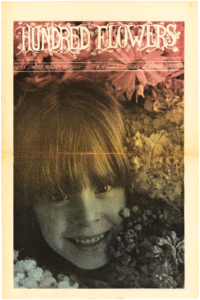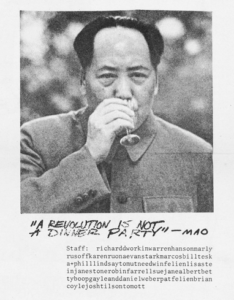 BY ED FELIEN
BY ED FELIEN
Let a hundred flowers blossom, let a hundred schools of thought contend.
For those of you who are irretrievably nostalgic about your wasted youth and want to relive the resistance to the war in Vietnam, the music and the fog of psychedelia (when you could pull up to a traffic light and the car next to you would hand you a joint), the beginning struggle for women’s liberation, the righteous relevance of the Black Panther Party and more, then you should go to Southside Pride’s website and click on the Hundred Flowers icon. This will take you back to April 17, 1970, and the first editions of Hundred Flowers, the first alternative/underground weekly newspaper in the Twin Cities.
Coming back to Minneapolis fresh from anti-war demonstrations in San Francisco and Berkeley, I wanted to publish a weekly anti-war paper with centerfolds of revolutionary heroes like Dock of the Bay, graphics like The Oracle and politics of The Seed. I had a little money left over from my teaching gig at Smith, so I was de facto publisher because I could pay for printing; Dickie Dworkin was the only one of us who had ever worked on a paper, so he was editor; and Warren Hanson had a graphic sensibility, so he was art director. The three of us were the core but we were supported by scores of volunteers who wrote and sold papers for us. We had collective meetings every Monday where we critiqued the last issue and lined up articles for the next issue.
Another Flower speaks
BY WARREN HANSON
As an embellishment of the historical roots for the paper but definitely in the shade of Eddie and his vision and action agenda, I had spent a week putting up handbills around the university and Augsburg campus to hold a meeting to start an anti-war underground newspaper and poetry magazine. I have to confess that art and poetry and graphics were part of the spiel, and that there would be a meeting at my (very small, rented) house at 2300 23rd Ave. in the heart of the Seward neighborhood. Instead of having maybe a dozen people show up for this organizing meeting, there were somewhere between 30 and 50 people who showed up, all excited. Eddie was one, and probably brought 10 others from his tribe. There was much chaotic discussion where I introduced the general idea but as was the case with scores of subsequent newspaper meetings, Eddie, who looked exactly like Charlie Manson (to me) at that point with a substantial beard and long hair, and I believe other members of the Georgeville commune, were adamant about exactly what type of underground newspaper we should publish. There were some who wanted to have a poetry and music-oriented publication. I confess I was in that camp at that particular naive point in my political development. And a very adamant contingent that wanted something that would be just like the Berkeley Barb. I recall Eddie saying it had to be like the Berkeley Barb and absolutely had to be political. The meeting lasted about three hours, with people standing around in the front yard smoking cigarettes and others still engaged in a nose-to-nose discussion about the nature of the magazine in my small living room in this very small house I was renting. At the end Eddie and I discussed how to proceed – basically, that we would be in touch. I realized I needed Eddie. He was older, wiser, and knew the steps to take better than anyone. My memory is completely a blank as to what happened between the time we held this meeting and the time I ended up, along with Dickie, living in Marly’s front sunroom. I do remember Eddie asking me early on if I would draw the logo for the newspaper, which I considered an honor. And I stayed up all night long illustrating that crazy logo with what I thought should have 100 flowers wrapping around all the calligraphy fonts. When Eddie came over to see it he was pleased with the logo, and we had a shared vision.
Anyway, that’s another version of the story. I did not come back from Berkeley on fire with the Berkeley Barb vision. I did not hail from the Georgeville commune. I did not have some ill-gotten-gain tax rebate to fund the initial print runs. I was totally naive, but I held the first meeting. I am pretty proud of that. Kidding aside, it just goes to show how serendipitous everything was and is to this day. And I soon made it out to the Georgeville commune with Eddie for more  discussion about starting the newspaper and had my eyes opened to free love, free pot, communal living in the rural town setting, and getting indoctrinated further by Keith Ruona around a potbellied stove and meeting all these cool commune members like Susie, Joan, Alan Jones, and others whose names Eddie could remember but not me.
discussion about starting the newspaper and had my eyes opened to free love, free pot, communal living in the rural town setting, and getting indoctrinated further by Keith Ruona around a potbellied stove and meeting all these cool commune members like Susie, Joan, Alan Jones, and others whose names Eddie could remember but not me.
I am sure there had been several energetic discussions at the Georgeville community about the newspaper plan too, before my U of M meeting.
So here’s what I recall about what brought me to Minneapolis
BY RICHARD DWORKIN
I was editor-in-chief of a pretty good Chicago high school newspaper and assumed the same role at college after my first semester there. But many things — including firsthand experience with the police riots at the Democratic National Convention of 1968 and SDS’s Days of Rage in the fall of 1969 — inspired me to be more involved with antiwar, progressive political action and countercultural life than I felt was possible at a small, relatively isolated campus. So I thought I would drop out of college for a year and see what else life offered.
In early 1970, after a few layabout months, I attended a weeklong-or-so workshop for left-leaning younger adults at Saul Alinsky’s Industrial Areas Foundation in Chicago. I was 18 years old, perhaps the youngest person present. Among the experienced activists I met there was Minneapolis’s Marv Davidov, probably the oldest attendee, whom I understood to be a former Freedom Rider. Marv told me about starting the Honeywell Project, created to end that company’s manufacture of anti-personnel weapons used against civilians in Southeast Asia. He then asked what I did, and when I said something about journalism, he said, oh, why don’t you come to Minneapolis, we really need a newspaper.
That’s how I ended up packing a suitcase of clothes, a typewriter, and a toothbrush and driving to Minneapolis, where I knew almost no one and virtually nothing about the city, the state, or even living independently. But at that age, in that time, things moved quickly. Somehow Marv hooked me up with a place to stay and a few contacts, and within a couple of months Ed Felien, Warren Hanson, Marly Rusoff, Brian Coyle, Tom Utne, I, and several others had produced the first issue of Hundred Flowers.
























